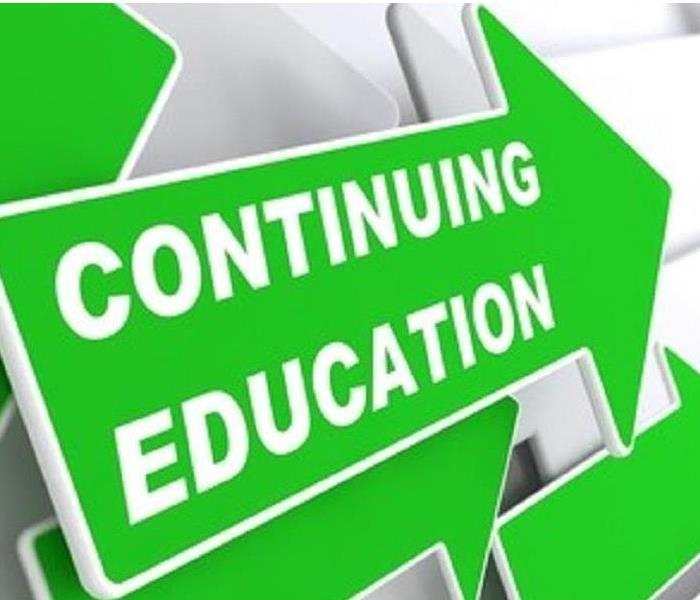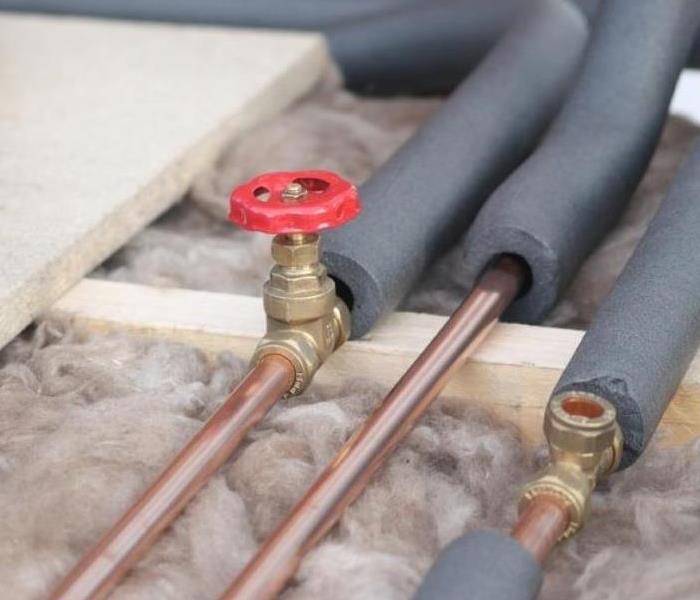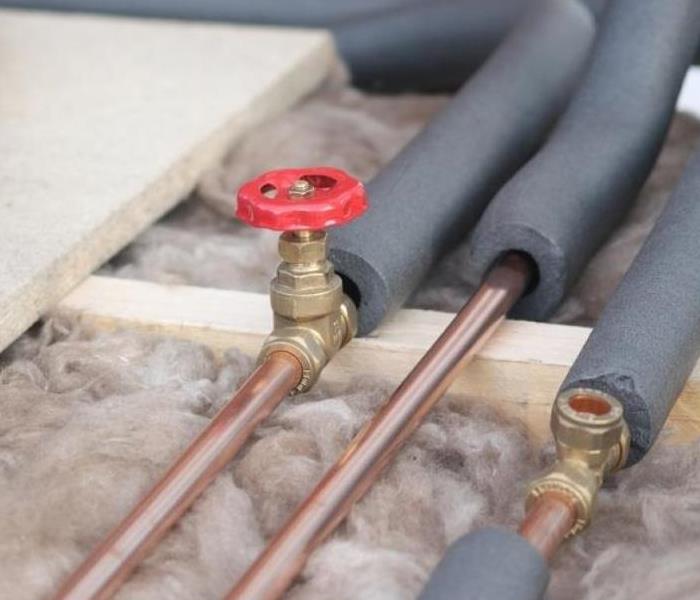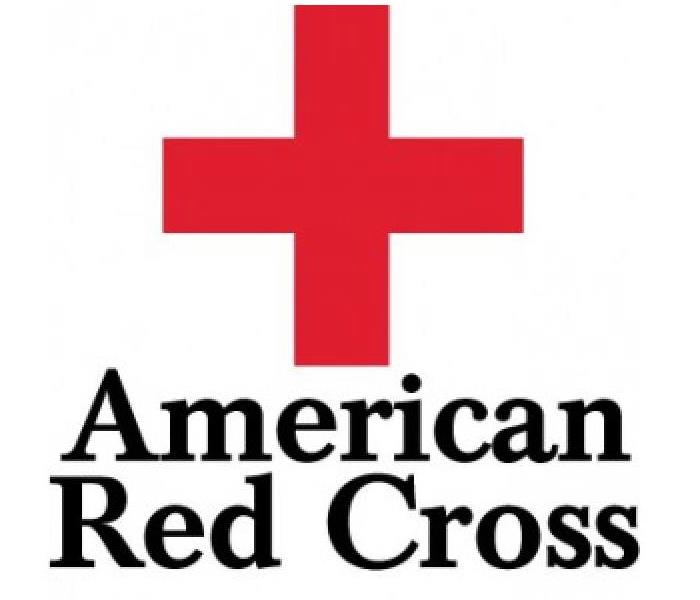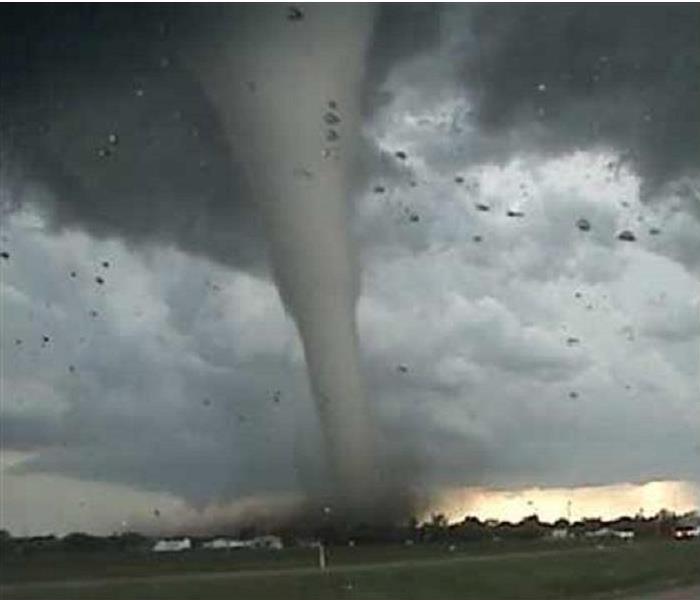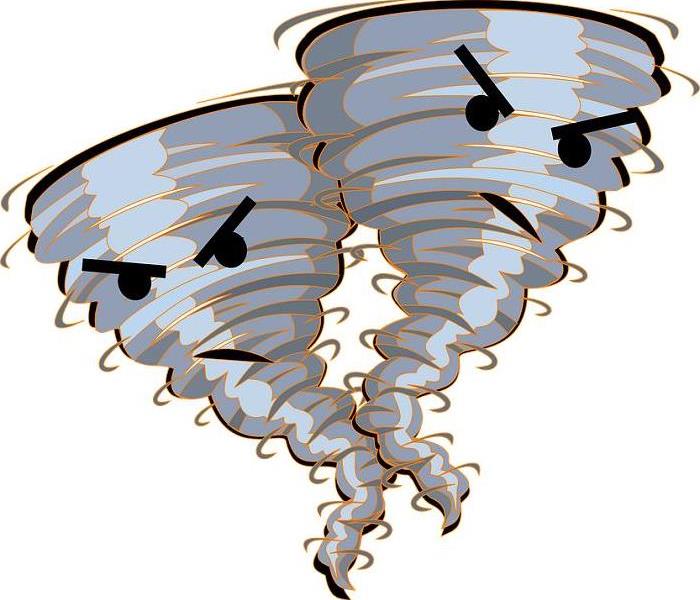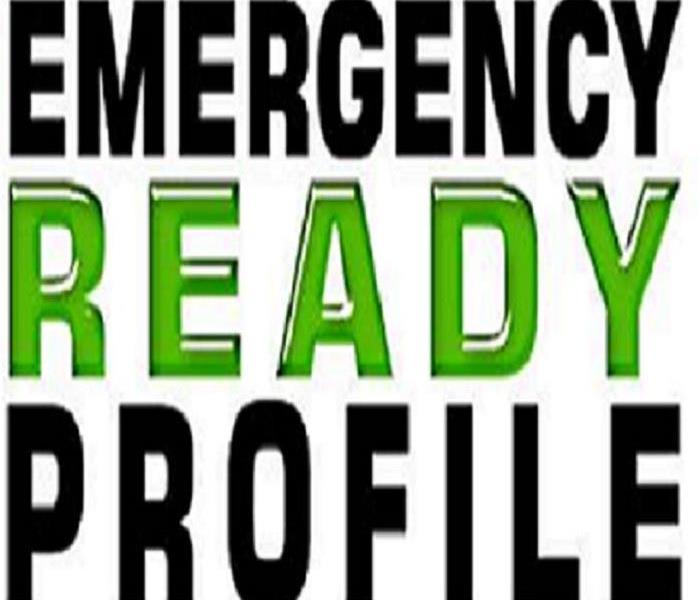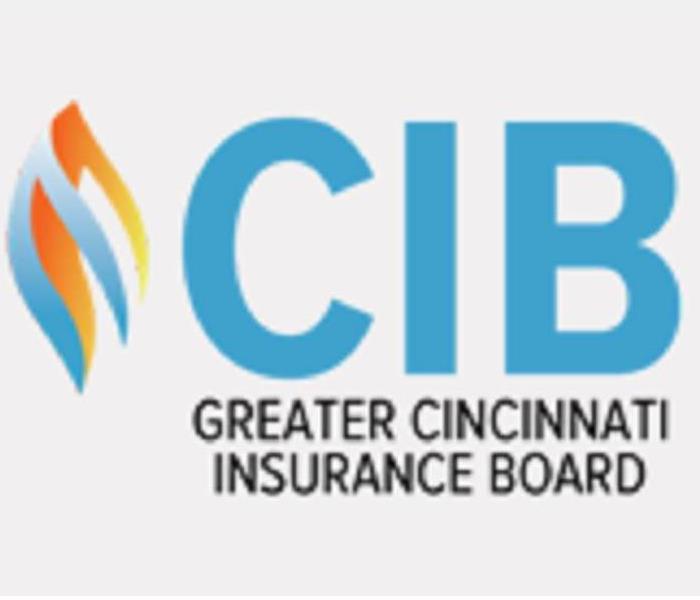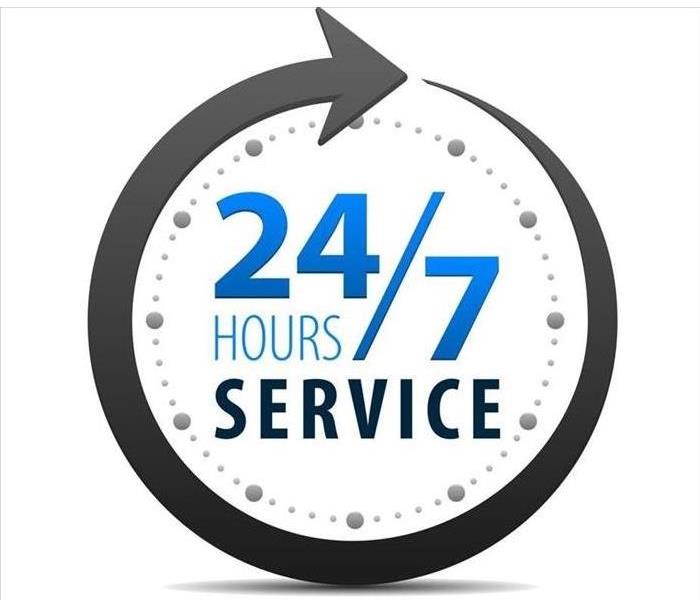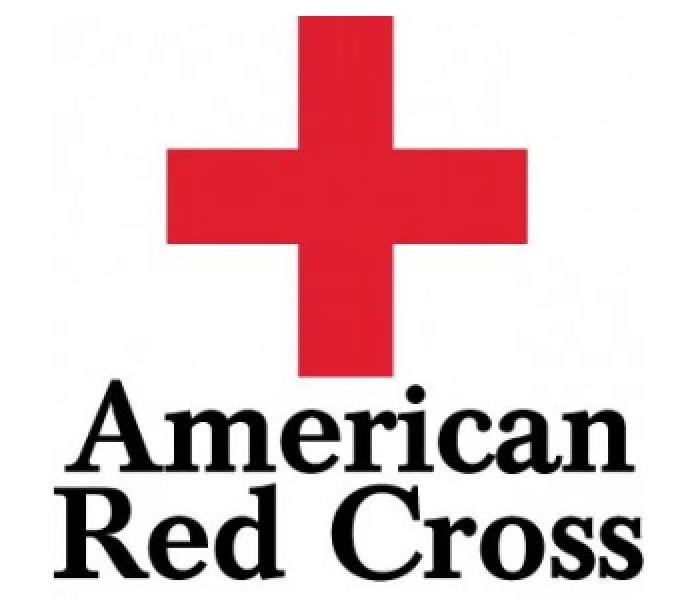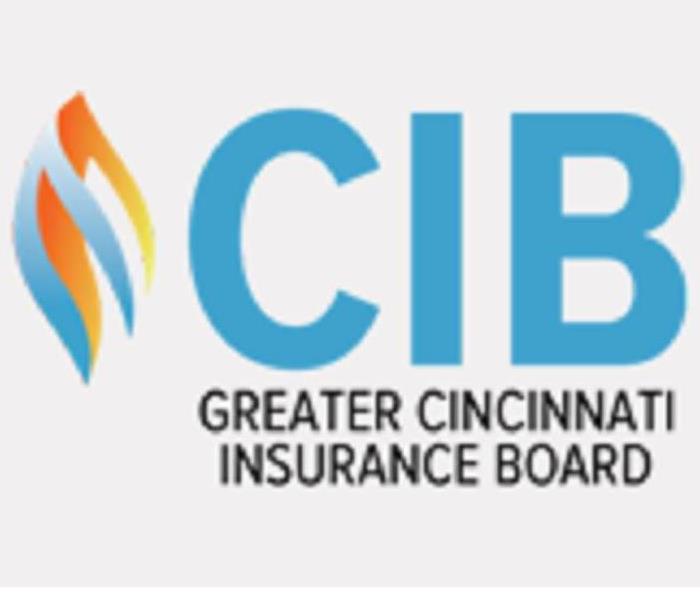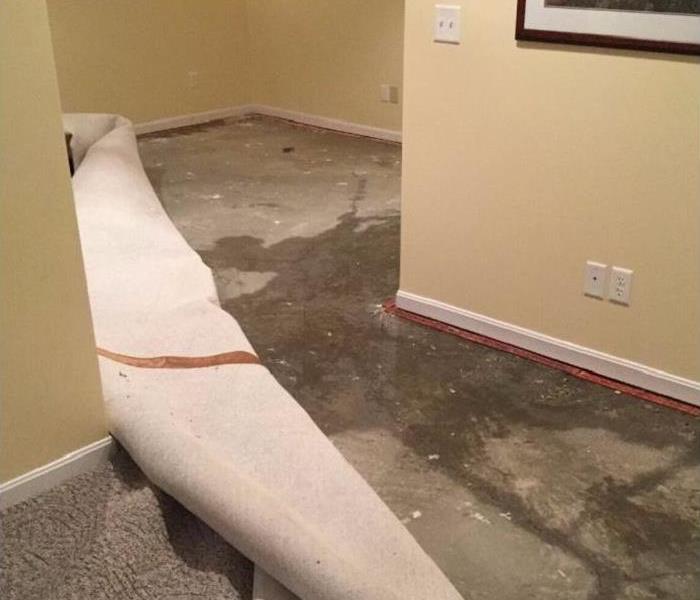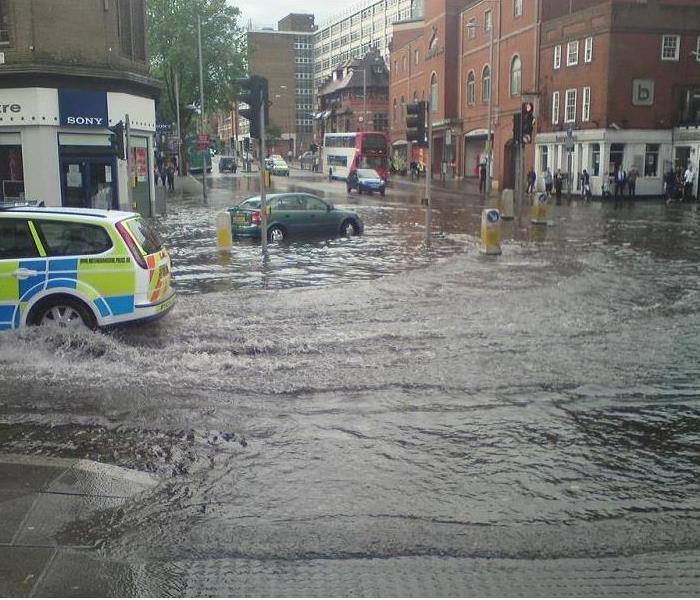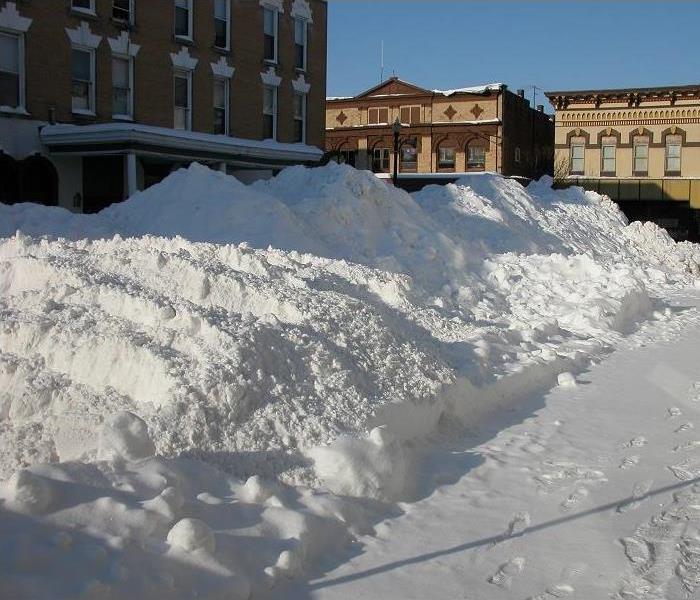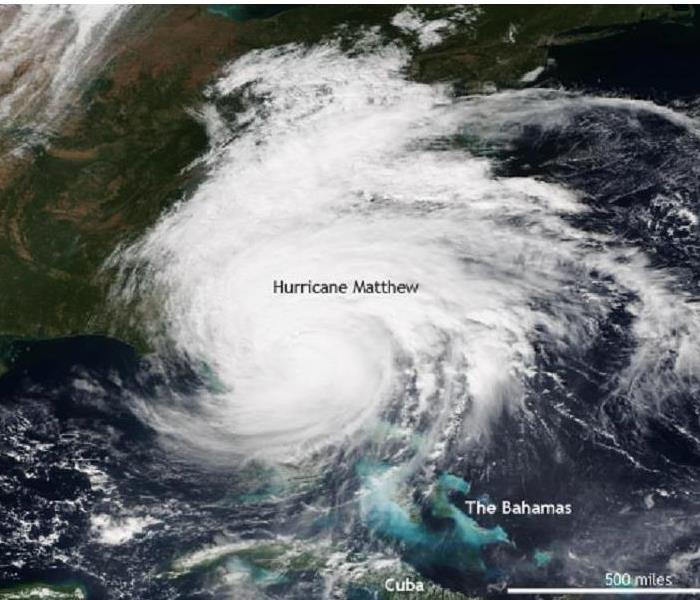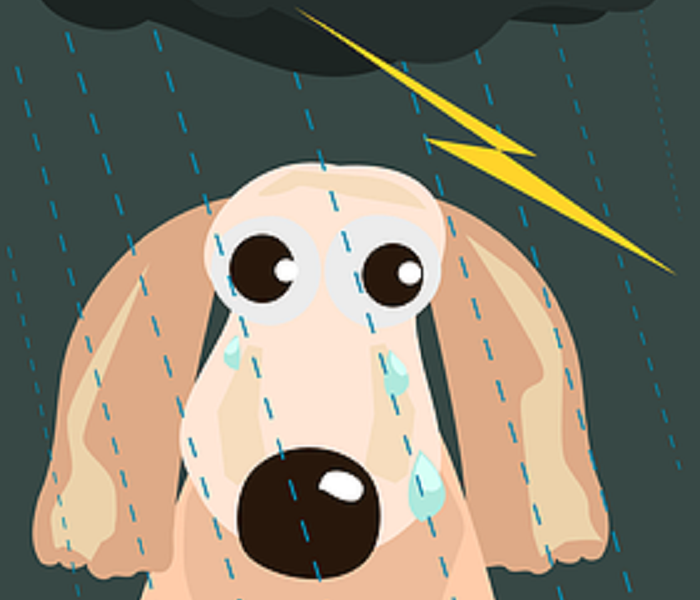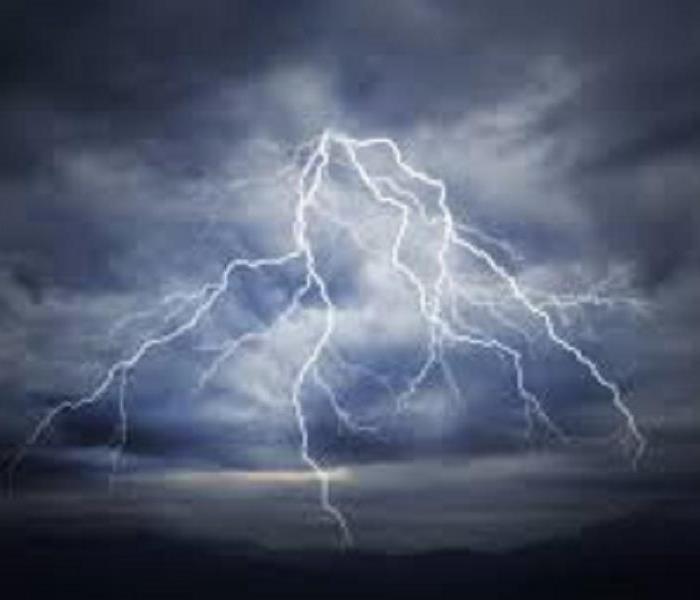Recent Storm Damage Posts
Winter storm damage
1/13/2025 (Permalink)
Hail is a form of solid precipitation that consists of balls of ice called hailstone and occurs during severe storms. According to the National Storm Damage Center, hail causes approximately $1 billion in damages per year in the United States to homes, buildings, cars, and crops.
Types of Hail Damage
Roof Damage – When hail storms hit, the most common damage to homes and buildings is to the roof. When the roof damage goes undetected or unrepaired, more damage can occur to the home or building as water leaks through the roof and into the walls.
Window and Siding Damage – Often high winds accompany hailstorms causing the hail to fall at angles. When this happens, windows and siding can crack which also leads to the threat for additional water damage to the home.
Automobile Damage – The glass, plastic and metal surfaces of vehicles are particularly susceptible to damage from hail. Dents in the metal or cracks in the windshield glass are common occurrences in hailstorms.
Steps to Minimize Hail Damage
There are a few steps that one can take to minimize hail damage.
Close Curtains or Blinds – Closing the window treatments can help prevent the wind from blowing broken glass into the interior of the building.
Park in Garage – To protect vehicles, park inside a garage or under a carport.
New Roof – If replacing your roof, consider using impact-resistant materials to help avoid future hail damage.
Hailstorms can be extremely destructive to commercial or residential buildings, especially roofs. If you are caught in a hailstorm and suspect that you have damage, SERVPRO of Boone County provides 24 hour emergency restoration services including board ups and roof tarps. We respond quickly to prevent further damage to your property!
Just call SERVPRO of Boone County! 859-746-3400
How to Limit Mold Growth After a Flood
10/2/2022 (Permalink)
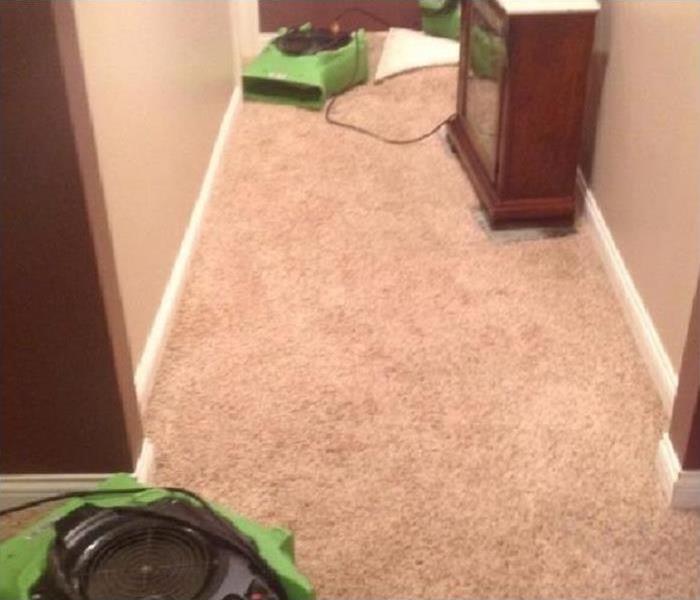 Drying completely an area will allow removing moisture from the air.
Drying completely an area will allow removing moisture from the air.
How to Prevent Mold After a Flood
If there is floodwater in your home after a storm in Union, KY, it can contribute to a variety of problems. A common issue for homeowners is mold growth. It only takes a short time for this fungus to grow and spread throughout your home when it has the proper conditions. Taking the right steps can keep this growth at a minimum.
1. Remove Excess Water
Mold requires moisture to grow so water damage from a flood creates a perfect opportunity. To reduce mold growth, it is important to remove as much water from the building as you can. Once this has been done, allow everything to dry completely. Using a dehumidifier to remove moisture from the air can be helpful during this process.
2. Clean or Throw Out Damaged Property
Not only does flooding affect your house but also the items within it. Objects with hard surfaces are relatively easy to clean and can be quickly sanitized. On the other hand, porous and absorbent materials that hold water can contribute to the growth of mold if they are not thoroughly cleaned. Items that cannot be easily cleaned may need to be tossed and replaced instead.
3. Arrange For Professional Mold Removal
Because mold grows so quickly, it can be difficult to prevent it completely after a flood. A professional mold remediation company can find and remove mold that you may have missed. It is best to have this done by a professional as attempting to clean the mold on your own could spread it further throughout the house. These professionals can also treat the area to help prevent the mold from returning.
Mold growth is a common type of damage that occurs after a flood. You can limit the growth by reducing the amount of moisture in your home. If there is a mold infestation, professionals can help you remove the fungus and keep it from returning.
How Does FEMA Help Homeowners After Storms?
8/25/2022 (Permalink)
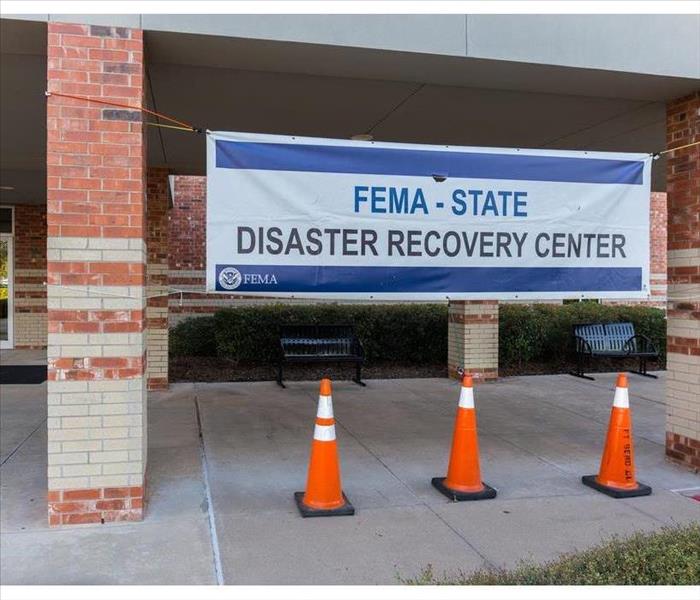 FEMA can aid you after a storm
FEMA can aid you after a storm
How Does FEMA Assist Homeowners Following Storms?
After your home in Hebron, KY, has been affected by storms and flooding, it can be helpful to seek assistance. Understanding how FEMA (Federal Emergency Management Agency) can assist homeowners can be useful to you after a flood.
1. Evaluates the Home
Once your application for assistance has been received and when it is safe to do so, the agency will send someone from the organization to evaluate your home. Storms can cause a vast amount of damage to a home, and it’s important that each home is assessed on an individual basis. Homes that have sustained widespread damage may require more thorough evaluations, whereas homes that have only been minorly impacted will likely be quicker since damage can be more easily spotted.
2. Provides Documentation
In addition to evaluating the damage that has occurred to your home, FEMA also will document the damage as well. This documentation is often necessary in order for the agency to determine whether or not you qualify for financial aid. Many insurance companies require documentation after a storm has occurred, so it can also be helpful to send the information to your insurance provider.
3. Offers Compensation
In some circumstances, the agency offers financial aid to homeowners whose homes have been majorly affected by a disaster. Regardless of whether or not you do receive aid, you the organization will send you a letter explaining how the decision was made. If you have received aid, the letter will generally suggest that you spend the money on services and items that will improve the state of your home, such as emergency restoration services. Those who were denied aid, however, can make an appeal.
Knowing how FEMA can aid you after a storm can you determine what additional assistance you may require. After a storm, the agency will evaluate your home, document what has occurred and may provide you with compensation.
Risks of Property Flooding After a Fire
6/23/2022 (Permalink)
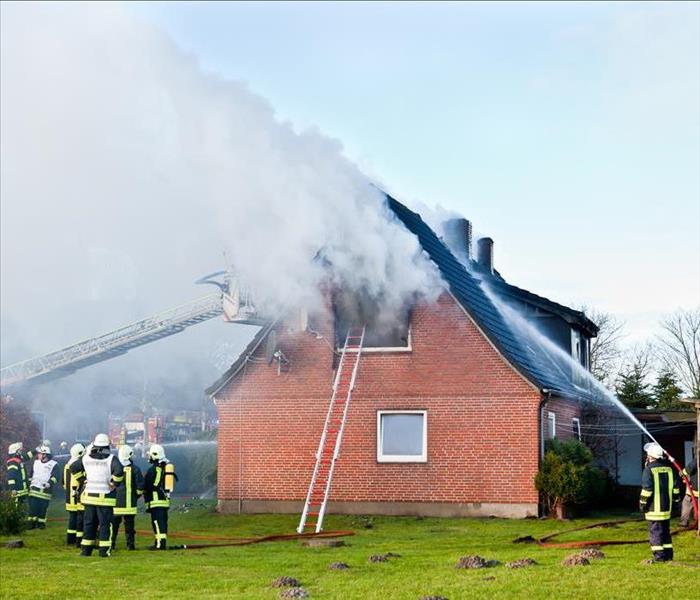 Firefighters use specialized hoses which unleash hundreds of gallons of water on a house.
Firefighters use specialized hoses which unleash hundreds of gallons of water on a house.
Property Flooding Risks Following a Fire
The FEMA NFIP, or national flood insurance program, is one way the federal government hopes to protect homeowners against flood damage, especially through unexpected circumstances, such as fire floods. According to flood damage restoration services in Florence, KY, flooding after a fire is more common than many homeowners think.
1. Suppression and Rescue System Flooding Damage
Most flooding actually occurs during rescue efforts. Firefighters use specialized hoses which unleash hundreds of gallons of water on a house every minute. While the water is effective for subduing and smothering flames, it will not all evaporate in the heat.
Additionally, if your house is outfitted with a sprinkler system, it too can lead to flooding. Most sprinkler systems do not work selectively, meaning when it goes off, it goes off everywhere in the house or structure.
2. Storm Flooding
The FEMA NFIP can also protect against other possible floods after a fire, including those brought about by storm surges. Additionally, when your home experiences fire damage, it might have several holes through the exterior walls or the roof. Rain can access these points, resulting in flooding.
3. Damaged Infrastructure Flooding
Unless you live in certain areas, you might not consider the relationship between wildfire damage and flooding. Again, rescue efforts can result in flooding and water damage. However, wildfire can also damage critical infrastructure, such as water towers or city sewers, resulting in flooding in residential areas.
4. Damaged Plumbing
It is also possible that the heat from the house fire melts or damages plumbing within the household. The damage can affect supply lines, which can lead to extensive flooding in the property if the supply is not shut down externally.
The FEMA NFIP program is a valuable tool for families with flood zones. Still, it is necessary to understand that not all flooding stems from storm systems or fractured infrastructure.
Understanding Commercial Generators
6/4/2022 (Permalink)
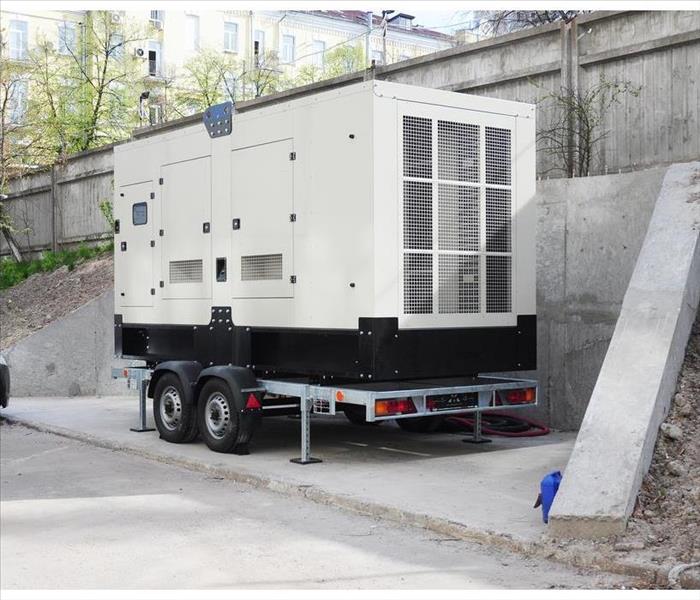 Make sure that you pick out the right generator for your business needs and budget
Make sure that you pick out the right generator for your business needs and budget
Three Things To Know About Commercial Generators
As a business owner in Crescent Springs, KY, it is important for you to understand how your commercial generators work, from learning how long they will last to knowing what to do if they break down. You will be thankful when and if a storm wipes out your building’s power and causes a potentially dangerous situation. Here are three things to know about your generator equipment.
1. Generators last through many uses. Typical models will work for about 3,000 hours, meaning that a typical standby option could last for more than 30 years. Contact the manufacturer of your unit for more specific information on its expected lifespan.
2. All generators are not the same. Some run on diesel, while others are fueled by natural gas. There are also prime, standby, portable and stationary models. Since there are all of these features and more that you must consider before making a purchase, make sure that you pick out the right generator for your business needs and budget.
3. Generator problems need to be considered. Even the best piece of equipment can malfunction. In the event of a broken unit, you must be prepared for flooding and other destruction that can take place, especially if bad weather is occurring. If something does happen to your business, a local commercial storm damage restoration company should be called as soon as the weather dies down so you can begin taking care of your damaged or wet property and belongings.
A responsible business owner should be aware of and understand all of the equipment that the company uses to keep things running smoothly. A generator should be no exception, even if it is just a portable model that is used sparingly. Stay in contact with your local repair shops, cleanup crews and other trusted professionals in Crescent Springs, KY, that can help when storms or other disasters threaten your property.
4 Important Facts About Nor'easter Storms
5/22/2022 (Permalink)
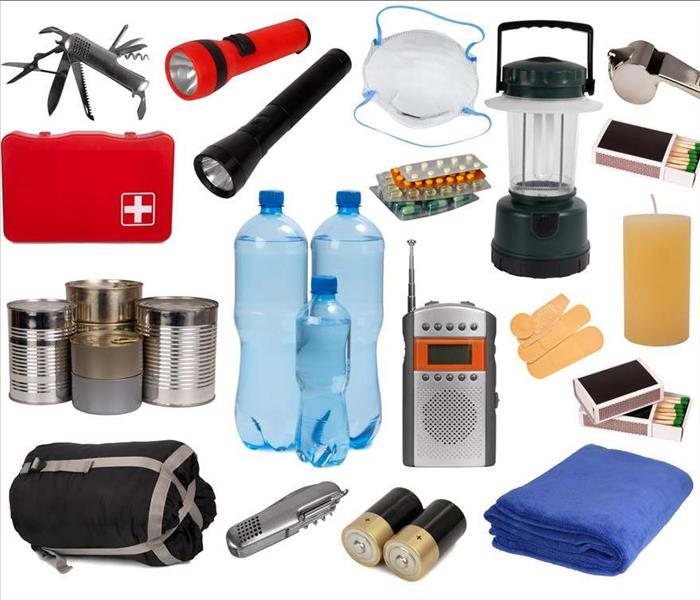 All households should have an emergency preparedness kit for weather emergencies.
All households should have an emergency preparedness kit for weather emergencies.
Nor'easter Facts
A Nor’easter is a powerful, low-pressure storm system that impacts the northeastern United States. These storms are responsible for some of the most remarkable snowfalls in American history, such as the 1888 Blizzard, the 1978 Blizzard and the 1993 Blizzard.
People located in Park Hills, KY, should prepare for severe weather by watching the news, having an emergency preparedness kit and knowing the following Nor’easter facts.
1. How and Where They Form
Limited to the eastern United States, these events typically originate near the coast of Georgia and New Jersey. Cities such as Boston, New York City, and Washington D.C. are particularly vulnerable due to their locations.
When warm Gulf Stream air mixes with cold air traveling down from Canada, it creates an unstable weather pattern. As the storm strengthens, it moves up the east coast with increasing intensity.
2. The Two Classification Categories: Miller Type A and Miller Type B
In 1946, scientist J.E. Miller began to classify the weather events as either Type A or Type B. The main difference between the types is where the systems develop. Type A versions are the most common and originate in the Gulf of Mexico, while the rarer Type B events form in the Midwest and travel east.
3. What to Expect: Snow, Flooding and More
A Nor’easter can cause blizzards, excess water and high winds. Storm season typically runs from early fall through spring.
During a storm, power outages, transportation delays and flight cancellations should be expected. If your home sustains damage, a severe weather remediation specialist can help you get back on track.
4. How To Prepare
All households should have an emergency preparedness kit for weather emergencies. It should include extra water, canned food, a flashlight, a battery-operated radio and blankets. Travel should be avoided, if possible, until the threat subsides.
A Nor’easter can cause power outages and travel disruptions. However, with preparedness and weather monitoring, they can be safely endured.
4 Steps To Stop Sewage From Backing Up Into a Bathtub
5/3/2022 (Permalink)
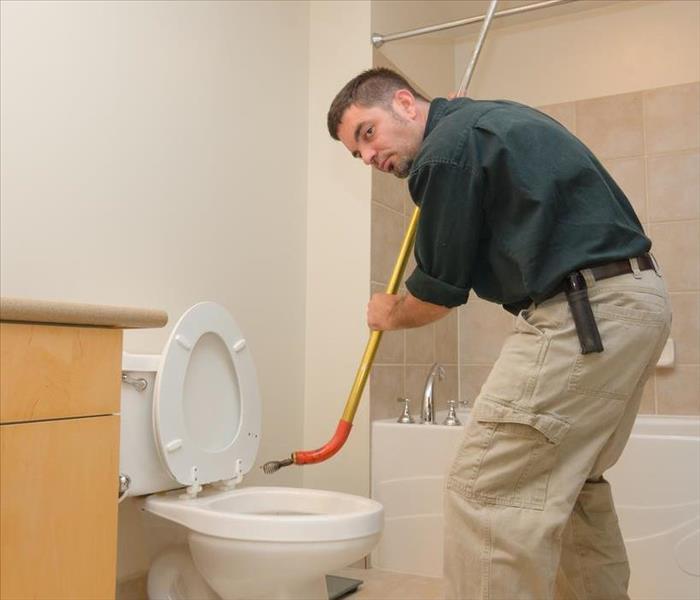 Insert a plumbing snake into a toilet.
Insert a plumbing snake into a toilet.
Stop Contaminated Water From Backing Up Into a Bathtub
There are several steps you can take to stop contaminated water from backing up into a bathtub. Depending on your level of plumbing skill and the location and severity of a blockage, it may be possible to stop a sewer backup on your own. If your efforts are not successful, you should contact a plumber or sewage company in Erlanger, KY.
1. Block the Tub Drain
Blocking a tub drain will prevent sewage from backing up into the tub. Take this step prior to attempting to clear a clog.
2. Locate the Blockage
It may be more or less difficult to clear a clog depending on its location. Clogs in lines near a toilet can usually be cleared with a plunger or auger. If these attempts do not work, the sewer backup may be located further down the line.
3. Snake the Toilet, Floor Drain or Cleanout
Depending on the evident location of a blockage, you can insert a plumbing snake into a toilet, remove the toilet to directly snake out the floor drain, or snake the drain cleanout. The main drain is typically located in a basement or crawlspace. Use a long pipe wrench to remove the cap and insert the auger. Look out for sewage overflow.
4. Call a Plumber or Sewage Company
If these efforts are not successful, you should contact a plumber if you suspect the clog originates on the residential end or a sewage company for a backed-up municipal main. If backup results in flooding, sewer damage mitigation will also be necessary.
Blocking a tub drain can stop a bathtub backup. You should also try to limit the spread of contaminated water caused by a sewer backup. Disinfect and dry any surfaces, materials or contents exposed to sewage. You may want to seek assistance from a mitigation and restoration company in Erlanger, KY.
Arm Yourself against Covid-19
8/31/2021 (Permalink)
 Stop the spread of Covid-19 by taking preventative cleaning measures.
Stop the spread of Covid-19 by taking preventative cleaning measures.
Like you, we wish life could go back to normal. Unfortunately, the Delta variant is making that difficult. As covid-19 cases soar in Hamilton, Boone, & Kenton County SERVPRO wants to ensure your health and safety. Keeping your facilities clean is crucial to your health and the health of your employees. Here are some of the steps we will take to ensuring your health and safety.
Routine Cleaning
SERVPRO uses cleaning products that are CDC certified to disinfect the Covid-19 virus. If you are looking for preventative measures to ensure the health and safety of your employees give us a call. We offer regular cleaning services that will disinfect all surfaces so you and your employees can feel comfortable coming to the office day in and day out. Whether you are looking for weekly or monthly preventative cleaning we have the services that you need.
Cleaning After a Positive Case
If you or an employee have received a positive Covid-19 infection the CDC also recommends that any employee that could have had potentially close contact with the infected individual quarantine for 14 days. Before your employees return you’ll want to clean the facilities. Continue using certified disinfectants that kill Covid 19. Wipe down any and all surfaces especially phones, keyboards, mouses. Each employee should have their own station so that they aren’t using anyone else’s electronics.
When vacuuming wear a mask. Most vacuum cleaners will blow air up towards your face potentially exposing you to the virus. When using cleaners be sure to wear gloves. When dealing with a positive case of Covid-19 it’s a good idea to consider wearing full PPE to protect yourself and others from the virus. And remember make sure the area is well ventilated and don’t mix chemicals like ammonia and bleach the fumes are toxic and could cause serious illness and injury.
Above all else our office wants you to stay safe and healthy. That’s why we offer free, no contact estimates for all of your covid cleaning needs. If you need assistance sterilizing your office call us at (513) 541-3200 “we are always here to help.”
Prepare Your Urban Businesses and Homes For Stronger Thunderstorms
6/22/2021 (Permalink)
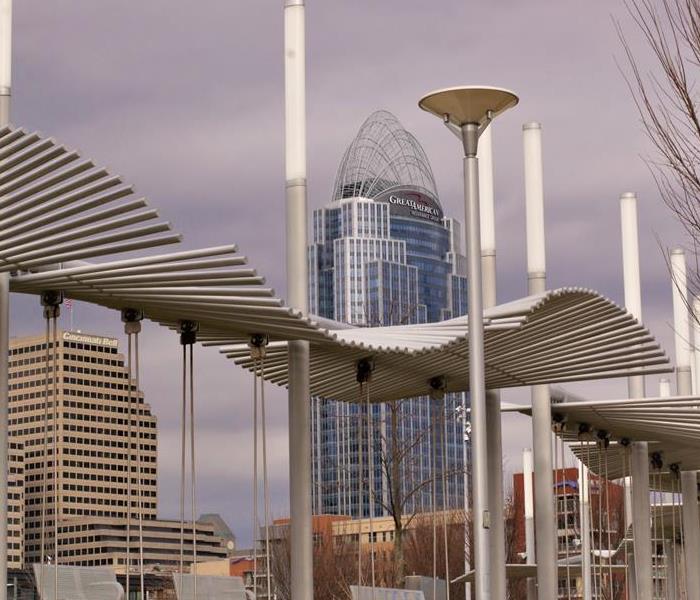 Cincinnati is going to great lengths to reduce the Urban Heat Island impacts.
Cincinnati is going to great lengths to reduce the Urban Heat Island impacts.
Have you ever noticed that in downtown Cincinnati or Covington, the temperature feels warmer by 2-5 degrees? It’s no coincidence. It actually is warmer! For centuries researchers have been studying this phenomenon. Scientists call it the Urban Heat Island Effect. Studies have shown that Urban areas like Cincinnati, Bellevue, and Covington have more severe storms because of this anomaly. The population in urban areas is predicted to increase in the coming years. SERVPRO wants to help you prepare your property now to decrease storm damage later.
What is an Urban Heat Island?
Urban Heat Islands, or UHI, are densely populated cities where buildings are built closely together. Generally, these areas have a large amount of surface area made from asphalt, concrete, steel, and other heat absorbent materials. It’s not just the building materials that make a UHI. Activities that create heat like driving, manufacturing, even a person walking can add heat to these tight spaces and raise the temperature. These factors mean the heat is trapped in the landscape. That is what creates the 2-5 degree difference in large cities.
How Does This Effect Create Stronger Storms?
There is more to a UHI than the temperature differential. The climate inside these areas is actually different. Nasa explains the reason behind this difference best, “increased temperature may provide a source of unstable air. If air over a city is warmer than the air surrounding it, it wants to rise. As the city-warmed air rises, it cools and forms rain-producing clouds that soak the area downwind.” These factors potentially create more severe weather than what might occur in the neighboring suburbs and rural areas.
Meteorologynews.com quotes Climatologist Dev Niyogi of Purdue University in Indiana, who believes, “As we are becoming bigger and bigger in terms of our urban footprint, there’s a distinct probability we are going to see cities have their own weather patterns.” For Cincinnati and Northern Kentucky, this means higher river levels and more frequent flooding.
Protecting Your Property From Storm Damage
The best thing you can do to protect your property from storm damage is to click here for maintenance suggestions. These tips can help prevent storm damage altogether or reduce the damage to your property. Scientists believe there is more than maintenance required to reduce property damage. Changes to how we use our urban spaces are also necessary. It is possible to reverse the effects of a UHI by taking these steps.
- Add Greenspaces
- Part of the problem with UHIs is the lack of plant life in downtown areas. Businesses and homeowners can help by planting gardens on their roofs. Sometimes roof gardens aren't possible. Your home or business may have a peaked roof or no roof access at all. Consider replacing lawn or concrete with a native garden bed instead.
- Plant Trees
- The EPA explains, “Trees shade buildings to directly reduce cooling energy demand by blocking the sun's radiation. Indirectly, trees use solar energy to release moisture into the atmosphere in the form of water vapor, which has an additional cooling effect.”
- Use light colors on your roof and ground cover.
- Dark surfaces absorb and hold onto the sun’s rays at a higher rate than lighter surfaces. Painting a roof white can reflect the light and decrease the heat absorption better than a black roof.
Should a large storm hit your home or business give SERVPRO a call. Our elite large-loss specialists are prequalified and strategically positioned throughout the United States to handle any size disaster.
Should it Stay or Should it Go Now: Tips To Tell If Your Tree is a Potential Hazard
5/20/2021 (Permalink)
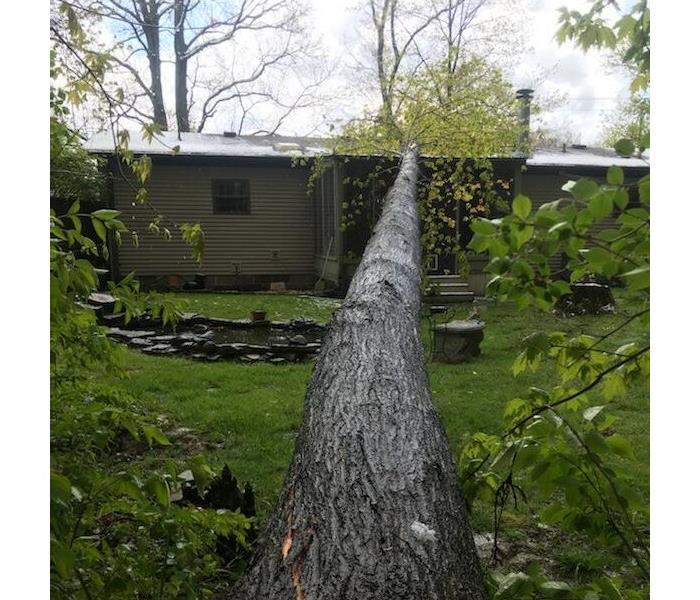 A felled tree damaging property after a storm in Goshen Ohio.
A felled tree damaging property after a storm in Goshen Ohio.
When you think of a tree falling on your home, you imagine a dead tree, right? What if we told you that a tree does not have to be dead nor dying to be a hazard? Many factors play into whether or not a tree has the potential to fall and cause damage to your property. Today, we are going to delve deeper into these potential environmental hazards.
Structure
The structure of a tree is key to whether or not it can withstanding a storm and high winds. Scientific American did interviews with several Arborists. David R. Foster, Director, Harvard Forest at Harvard University explains,
Wood is a very strong and wonderful structural material. Wood, however, is not homogeneous or consistently strong at all places in the stem (trunk). Wood decay caused by fungi can weaken wood structure. However, the mere presence of decayed wood or even a hollow does not mean that the tree is more vulnerable to failure.” What he says next is of some comfort. “Strength comes from the quality and quantity of wood that is present, not what might have been degraded."
There are many reasons that a tree might not have a strong structure. Animals and bugs can do a lot of damage to a tree. We have all heard of the emerald ash borer. Bugs like this and the Asian long-horned beetle can kill a tree that has lived for 100 years in as little as 5-10 years. These bugs degrade the quality and quantity of wood in the infested tree.
In addition to bugs, you also have other organisms that can leach the nutrients from the tree. Mushrooms and vines are the biggest parasitic culprits. Hen-of-the-Wood and invasive vines like English Ivy have a parasitic relationship. Vines and mushrooms slowly kill trees by stealing their nutrients. Vines will wrap around a tree and branch out its own canopy stealing the light from the tree itself. To be clear, not all mushrooms and vines are parasitic. Boletes are a good example of mushroom that has a symbiotic relationship.
Softwood trees like poplars and pines grow quickly. This causes them to be weak. In some instances, these quick-growing trees can have holes in the middle. Compromising the structure. This makes them a potential hazard come winter when they are weighed down by snow or whipped around in a storm.
Human manipulation can also weaken trees. When done correctly pruning, can encourage new, healthier growth. Oregon State University explains that it's best to prune during the tree's dormant period. For most trees, late fall is ideal. This helps the tree recover from being cut and helps prevent disease and possible insect infestations.
But, many people do not know the proper way to prune a tree. If you are going to do it yourself be sure you are doing it in the right places. You should also be careful that you're not cutting the tree back too much. Over pruning can cause an imbalance in the tree’s structure, making large branches susceptible to felling when high winds or inclement weather hits. Not cutting it in the right spot could do the same thing.
Soil
Before you plant a new tree it’s important to know two key factors about your tree and soil. What kind of soil do you have? If you’re in Cincinnati and Northern Kentucky, the soil on your property is most likely clay. Clay is a dense compact soil that tends to hold a lot of water. This can be a bad combination when we get a lot of rain. Lots of rain and saturated soil could be the recipe for an uprooted tree.
That’s why you should know what species of tree you are planting before you place it. Certain species thrive in different types of soils. According to the Ohio Department of Natural Resources, some of the best trees for clay are White oaks, Paw Paw, and, Silky Dogwood. A sapling will ideally adapt to its habitat. But, if you are transplanting trees that are a few years old and they're not known to thrive in clay, there is a higher risk of felling when they get older. The roots aren’t going to be able to penetrate past the clay. That means the root system only goes down a few inches versus the few feet that it needs for a good sturdy hold in the earth.
Urbanization
Newer developments could experience a higher rate of felled trees. In nature, we have what is called co-dominate trees. These are trees that grew up as saplings about the same time in different parts of a wooded area. A tree that grew up on the edge of the woods has more access to light. Therefore it can bush out rather than needing to grow up to reach the sunlight. This allows them to act as a buffer against the wind.
When these trees are cut down to make room for housing, a few things happen to the canopy trees. First, you’re taking away the wind buffers from trees that are, to put it simply, top-heavy. This can become a problem in the case of heavy winds, storms, and microbursts. These tall, straight trees with a heavy canopy no longer have a shield against the wind.
In addition to no longer having a wind block, trees that were once in the middle of a wooded area and now sit on the edge of woods lack the support of other root systems. This makes them vulnerable and creates a hazard for your property. The direction of the wind plays a role in this as well. In Cincinnati and Northern Kentucky, the wind commonly comes from the south and west. That means if these trees are facing the north and east the risk of being uprooted is reduced.
There are many factors as to whether or not your tree is a risk and susceptible to felling. If you have concerns about a tree that is close to your home contact your local Arborist. They can point you in the right direction and let you know if you have a healthy, sturdy tree or; if your tree is a potential threat.
We cannot emphasize this enough. Cutting down trees is dangerous work. Unless you are a professional or you are only pruning a small branch please do not attempt to cut down trees yourself. This includes emergencies like a tree or large branch falling on your house or vehicle. Professionals like us can remove trees quickly and safely off of your property. Should you find yourself in this dangerous situation, do not hesitate to call our office at (513) 541-3200.
Storm Damage in Cincinnati Ohio
4/30/2021 (Permalink)
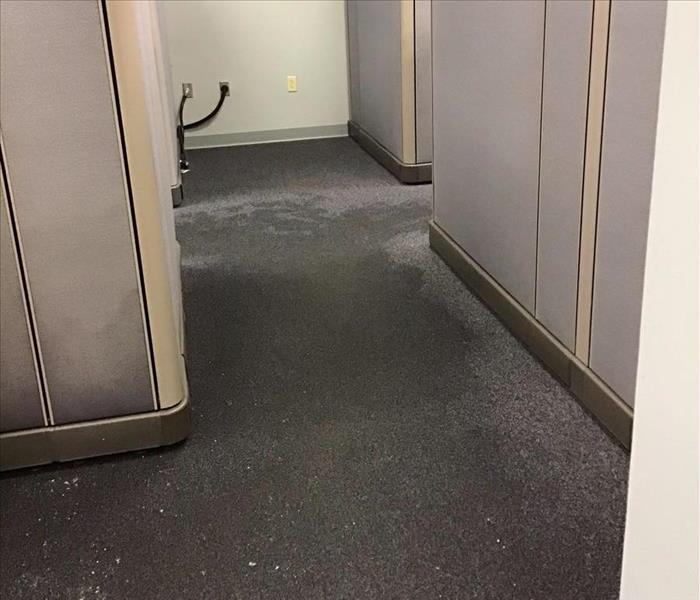 Commercial water damage on 4/29/21.
Commercial water damage on 4/29/21.
It rained cats and dogs yesterday. We weren’t sure it was ever going to stop. Luckily our crews were geared up and ready to go when we got the call for a commercial flood in Cincinnati, Ohio. While they didn’t sustain storm damage, they did have a fridge supply line leak. Two floors and numerous offices were affected by this leak.
We got the call from the property manager at 8:44 AM. Our crews were on site by 9:32 AM. We immediately began extracting water from the carpet. The carpet was so saturated you could see footprints every time you took a step! Afterward, they started removing cove bases so they could drill holes in the drywall. These holes allow air to flow behind the affected wall which, aids in the drying process.
The ceiling tiles also needed to be removed. The water from above had saturated those as well. Once all the demo was completed, our crews placed equipment on both levels. Most water damages take about 3 days to dry out. A larger like this one loss will sometimes take 5 days.
So what happens after the 3rd or 5th day? We keep working! We offer free repair estimates to all of our clients. So if you don't know who to use for your repairs, SERVPRO has your back! We want to make you feel like this water damage "never even happened."
April Showers Brings... Property Damage
3/31/2021 (Permalink)
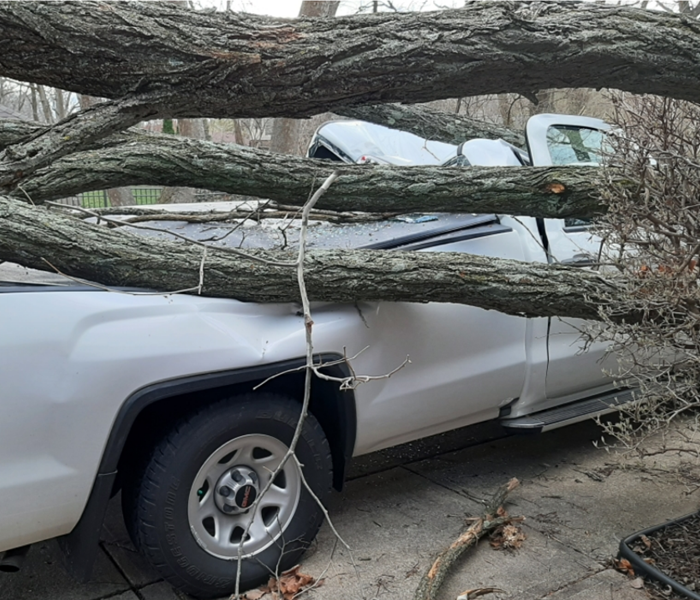 This tree fell on a truck during a storm on 3/26/2021. It blocked his driveway. We were called out to remove it.
This tree fell on a truck during a storm on 3/26/2021. It blocked his driveway. We were called out to remove it.
When it comes to bad weather Cincinnati and NKY are no strangers to storms. Current results, a statistical website, collected data between the years 1981-2010. With an average of 137 days per year, Cincinnati Ohio ranks number 8 for the most, rainy days nationwide! Covington isn’t far behind with an average of 132 days. While bad weather can hit at any moment our office has observed that most of this rain comes between the months of March-June. Are you ready for the storm? Let’s find out.
Insurance Coverage
One of the easiest things you can do to protect yourself from storm damage is to speak with your insurance agent about coverage. Insurance Information Institute says that there are 5 main things covered on your insurance policy:
- Fire
- Hurricane
- Hail
- Lightning
- Or other disasters
In most cases, this does not include flooding. You’ll want to ask your agent about what qualifies as flooding. Claims that we see declined most frequently around here involve water intrusion from the outside. This includes water that comes up from the foundation, water that comes through a window well, and water that comes from underneath an outside door.
Further details you’ll want to ask about is whether or not you have coverage for sump pump backups. Sewage backups are also an important discussion because even though you might have coverage there may be a cap on the amount of coverage. That amount will have to last you not only through mitigation but also repairs. Nobody is going to know your policy better than your agent. Having a discussion with them can help you prepare for this year’s storm season.
Home Repairs
Another important task is taking a walk around your house before a big storm hits. Look for situations in or on your home that could be problematic.
- Missing shingles
- Holes in your shingles
- Siding i.e. missing, crooked, or damaged pieces
- Check if your gutters are clean
- Repair any damages to your gutters
- Check that your sump pump is working properly
- Look for loose debris around your house
- Trim away dead branches or branches hanging over your roof
- Cut down dead trees that are close to your structure
- Inspect your windows for cracks and broken seals
- Clear leaves and debris from your drains
SERVPRO wants you to be prepared for this upcoming storm season. That’s why we also offer reconstruction services for any repairs you may need to make on your home to prevent further damage. Call us today for your free estimate and peace of mind.
Tips to Protect Your Home or Business from Lightning Strikes
3/30/2021 (Permalink)
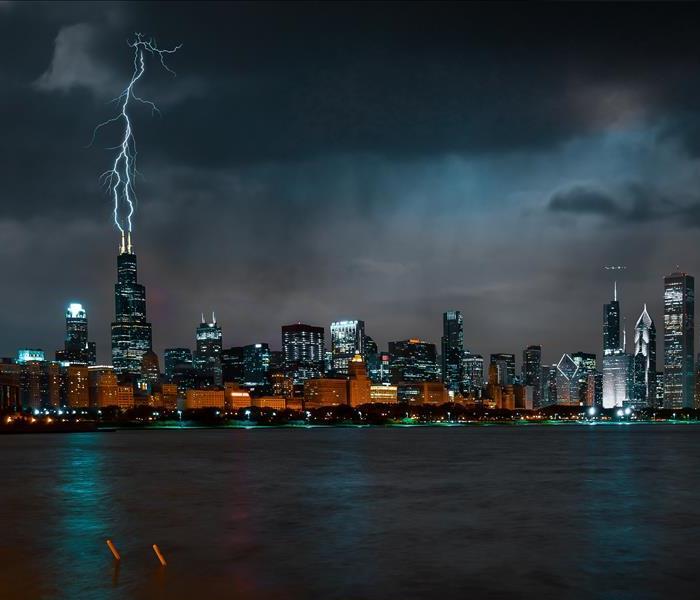 Photo by Bhargava Marripati from Pexels
Photo by Bhargava Marripati from Pexels
Watching the light show during a thunderstorm is awe-inspiring. But, those same lightning strikes are also a force to be reckoned with. Being inside a strong, solid structure during a storm is the safest place you can be. However, it does not offer you a 100% guarantee that you and your home or business are safe from lightning strikes. Insurance Information Institute shared a statistic that shows 19% of house fires are caused by lightning strikes. SERVPRO is dedicated to your health and safety. That's why we researched ways that could reduce the damage that can be caused to your home or business by lightning strikes.
Insurance information institute also shares an interesting quote by James Lynch, chief actuary and senior vice president of Research and Education at the Triple-I. “Homes are more susceptible to lightning damage because electronic systems have become more interconnected – think Smart Homes – which have an easy gateway to much of a home’s electronic network, damaging scores of devices and appliances at once.”
For this reason, we suggest the first thing you do during a storm is disconnect all unnecessary electronics. This will protect your devices and make your home slightly less conductive. Some sites also suggest buying surge protectors. This can help protect your devices from damage due to a lightning strike but it’s important to note that it doesn’t reduce your risk of your house getting struck by lightning during a storm.
During a storm, lightning can strike anywhere on the outside of your house. Most homes are wired to run electricity throughout the structure. That means if your home or business is struck by lighting the current can run through any and all paths that are conductive as it searches for its way to the ground. Storm Highway suggests that installing lightning rods is a great option to protect your house or business because it creates a direct path from the lightning strike to the ground. They emphasize that it may not be the most cost-effective method but it does reduce the risk of fire and bodily harm.
Unfortunately, there is no foolproof way to completely protect your house from lightning damage. But, there are ways to reduce the likelihood and effects of a lightning strike. If you do find yourself struck by disaster SERVPRO will be by your side every step of the way.
A Stormy Playlist to Get Your Day Started
2/8/2021 (Permalink)
 Waking up with SERVPRO
Waking up with SERVPRO
2/8/2021
We here at SERVPRO of Boone County know that mornings aren’t easy for everyone. That’s why our office has created a playlist to wake you up like a window-rattling thunderclap in the middle of a stormy night! When the coffee hasn’t kicked in yet just find our office playlist Singin’ In the Rain on Spotify and sing along with us!
Here’s just a glimpse of some of the songs you’ll find.
Storms
I Wish It Would Rain Down – Phil Collins
Thunderstruck - AC/DC
Every Storm (Runs out of Rain) - Gary Allen
Windy - The Association
Riders On The Storm - Doors
Blown Away - Carrie Underwood
The Eye - Brandi Carlile
Fairweather Friend - Jonny Gill
Storm - Life House
Whistles the Wind - Flogging Molly
Thunder Rolls - Garth Brooks
Umbrella - Rihanna
Two Sparrows In a Hurricane - Tanya Tucker
Storms - Fleetwood Mac
Riding the Storm Out - REO Speedwagon
Stormy Weather - Etta James
Cloudy - Simon & Garfunkel
Here Comes the Rain Again - Eurythmics
Rainbow - Kacey Musgraves
SERVPRO assists with Storm Damage
11/30/2020 (Permalink)
Did you know that SERVPRO offers emergency service 24 hours a day, 7 days a week? Fire, water, and storm damage doesn’t always strike during regular business hours. And often, at the most inconvenient times, homeowners find themselves in need of immediate service to secure their property after an emergency event.
SERVPRO can provide temporary protective measures to prevent additional damage to the property after a disaster. Examples of these services include board ups, roof tarps, tree removal, temporary fencing and portable power. If after a fire or flood, the contents of a property need to be removed from the affected property during the restoration process, SERVPRO can pack the contents and move them to our temporary warehouse location until the restoration process is complete. And once restoration is complete, the contents are then returned to the homeowners.
Emergency Storm Damage Assistance
10/21/2020 (Permalink)
Did you know that SERVPRO offers emergency service 24 hours a day, 7 days a week? Fire, water, and storm damage doesn’t always strike during regular business hours. And often, at the most inconvenient times, homeowners find themselves in need of immediate service to secure their property after an emergency event.
SERVPRO can provide temporary protective measures to prevent additional damage to the property after a disaster. Examples of these services include board ups, roof tarps, tree removal, temporary fencing and portable power. If after a fire or flood, the contents of a property need to be removed from the affected property during the restoration process, SERVPRO of Northwest Cincinnati can pack the contents and move them to our temporary warehouse location until the restoration process is complete. And once restoration is complete, the contents are then returned to the homeowners.
Flash Floods with Rainfall
8/26/2020 (Permalink)
Flash floods are usually caused by excessive rainfall that occurs in a short period of time. They are dangerous because they are powerful, speedy and unpredictable. They can happen with little or no warning at all.
Densely populated areas are at a high risk for flash floods. Buildings, roads and parking lots in the area reduce the amount of rain absorbed by the ground. Sometimes streams that run through cities are routed into storm drains. These drains can become overwhelmed and flash flooding can result.
Areas near rivers are also at risk for flash flooding. If levees along rivers fail, flash flooding can result. In 2005, New Orleans experienced devastating floods during Hurricane Katrina due to the failure of the levees.
Dam failures and rapid runoff from mountains and steep hills can also cause flash flooding. When water is falling faster than the ground can absorb it, a dangerous, flooding condition can result.
No area is really immune to flash flooding. During storms it is important to pay attention to weather watches and warnings and take the necessary precautions. Always listen to forecasters and be prepared with a plan in place just in case a flash flooding situation arises!
Storm Damage leads to Water Issues
8/25/2020 (Permalink)
When it comes to storm and other weather-related damage, many people only think of the exterior structural damage to their property like fallen trees and damaged roofs. But what some people fail to realize is that exterior storm damage can often lead to interior water damage to their property. Water will always travel the path of least resistance and unfortunately after exterior structural damage to a property, this often means the water will end up inside the property. A quick response is crucial to help limit the additional interior damage. In the event of water or storm damage, SERVPRO responds immediately, any time, day or night. We understand the importance of responding quickly to help prevent secondary damage and reduce restoration costs. Roofing service, board ups, roof tarps and tree removal are all among the emergency services we provide. Additionally, we are experts in water damage restoration and provide professional and efficient service to our customers.
Structural Damage from storms
6/19/2020 (Permalink)
When it comes to storm and other weather-related damage, many people only think of the exterior structural damage to their property like fallen trees and damaged roofs. But what some people fail to realize is that exterior storm damage can often lead to interior water damage to their property. Water will always travel the path of least resistance and unfortunately after exterior structural damage to a property, this often means the water will end up inside the property. A quick response is crucial to help limit the additional interior damage. In the event of water or storm damage, SERVPRO of Boone County responds immediately, any time, day or night. We understand the importance of responding quickly to help prevent secondary damage and reduce restoration costs. Roofing service, board ups, roof tarps and tree removal are all among the emergency services we provide. Additionally, we are experts in water damage restoration and provide professional and efficient service to our customers. CLICK HERE to learn more!
Hail Damage
5/12/2020 (Permalink)
Hailstorms can be extremely destructive to commercial or residential buildings, especially roofs. If you are caught in a hailstorm and suspect that you have damage, SERVPRO provides 24 hour emergency restoration services including board ups and roof tarps. We respond quickly to prevent further damage to your property!
Hail is a form of solid precipitation that consists of balls of ice called hailstone and occurs during severe storms. According to the National Storm Damage Center, hail causes approximately $1 billion in damages per year in the United States to homes, buildings, cars, and crops.
Types of Hail Damage
Roof Damage – When hail storms hit, the most common damage to homes and buildings is to the roof. When the roof damage goes undetected or unrepaired, more damage can occur to the home or building as water leaks through the roof and into the walls.
Window and Siding Damage – Often high winds accompany hailstorms causing the hail to fall at angles. When this happens, windows and siding can crack which also leads to the threat for additional water damage to the home.
Automobile Damage – The glass, plastic and metal surfaces of vehicles are particularly susceptible to damage from hail. Dents in the metal or cracks in the windshield glass are common occurrences in hailstorms.
Steps to Minimize Hail Damage
There are a few steps that one can take to minimize hail damage.
Close Curtains or Blinds – Closing the window treatments can help prevent the wind from blowing broken glass into the interior of the building.
Park in Garage – To protect vehicles, park inside a garage or under a carport.
New Roof – If replacing your roof, consider using impact-resistant materials to help avoid future hail damage.
Enter Our March Madness Bracket Challenge!
3/13/2020 (Permalink)
March is here, and we all know what that means…It is time for MARCH MADNESS! We are adding to the fun and excitement this year by hosting a March Madness Bracket Challenge. We are inviting everyone to join our Bracket Challenge for a chance to win prizes valued up to $200! And prizes will be awarded for our 1st, 2nd, and 3rd place winners! Not a basketball fan? That’s okay! You don’t have to be a basketball expert to play! It doesn’t matter what you base your picks on…best records, best uniforms, alma mater…whatever! To enter, simply click the link below, sign in, or create an account, and choose your favorite teams! Be sure to fill out your bracket before the opening games begin on Thursday, March 19th! Good luck!!
CLICK HERE TO ENTER!!
SERVPRO of Boone County to Offer Continuing Education Course on 1/28/20
1/20/2020 (Permalink)
We are offering a free continuing education insurance credit course entitled, “Ethics.” This course is for 3 credit hours in OHIO / KENTUCKY and will be held at our Cincinnati, Ohio location at 2115 Schappelle Lane, Cincinnati, Ohio, 45240 on January 28th, 2020 from 8:30am to 11:30am with registration beginning at 8:00am. Please note that 100% attendance is required to be eligible to receive the CE credits and that breakfast will be provided!
The premise for this course is that although we may have solid ethical foundations and usually make rational ethical decisions, ethical lapses are likely to come when we are stressed, angry, upset or worried. We will explore what “Ethics” is by participating in group activities that will help with understanding and making ethical decisions.
For more information and reservations, contact Meg O’Brien at 513-614-1047 or email at mobrien@hartkes.com.
Course Number: C10183-KY, 37868-OH
Steps to Thaw Frozen Pipes
12/2/2019 (Permalink)
During the cold months, we often see water damage situations as a result of frozen and bursting pipes. If you turn on your faucet, and only a trickle of water comes out, a frozen pipe may just be the culprit. If you suspect that you have a frozen pipe, care must be taken when thawing, because if the pipe has already burst, water will flood your home. If the pipe has burst, it is important to turn off the water at the main shutoff valve.
If the water is still running and the pipe has not yet burst, there are steps that can be taken to try to thaw the pipe.
- Turn on the faucet. As you heat and thaw the pipe, you want the water to be able to flow through.
- Using an electric heating pad wrapped around the pipe, an electric hair dryer, or a portable space heather, apply heat to the frozen section of the pipe. Apply the heat to the pipe until full water pressure is restored.
- Check all other faucets in the home for potentially frozen pipes.
If it’s too late and you end up with a burst pipe and water damage in your home, remember that SERVPRO of Boone County is available 24 hours a day to provide emergency service!
Beware of Frozen Pipes this Winter!
11/4/2019 (Permalink)
As we near the cold, winter months, the risk for frozen pipes increases. And burst pipes is one of the most common causes of water damage to properties during the winter.
Pipes most at risk for freezing are those located in the unheated interior spaces of a property such as basements, attics, and garages. Luckily, there are steps that can be taken to help keep the pipes warm, the water running, and your property dry!
- If there are water supply lines in the garage, always keep the garage doors closed.
- In order to keep warmer air circulating around the pipes, open kitchen and bathroom cabinet doors.
- Let the cold water slowly drip from the faucets.
- If you plan to be away during the cold months, keep the heat on and set the temperature to no lower than 55 degrees F.
- Add insulation to attics, basements, and crawl spaces.
Experiencing water damage can be very stressful and, depending on the extent of the damage, also very costly. It is important to be aware of the common causes of water damage and take steps to alleviate the risks as much as possible.
If you find yourself with a water damage situation in your property, SERVPRO of Boone County is always here to help. CLICK HERE to learn more about the steps of the water damage restoration process.
Structural Damage from Storms Can Cause Interior Water Damage
10/21/2019 (Permalink)
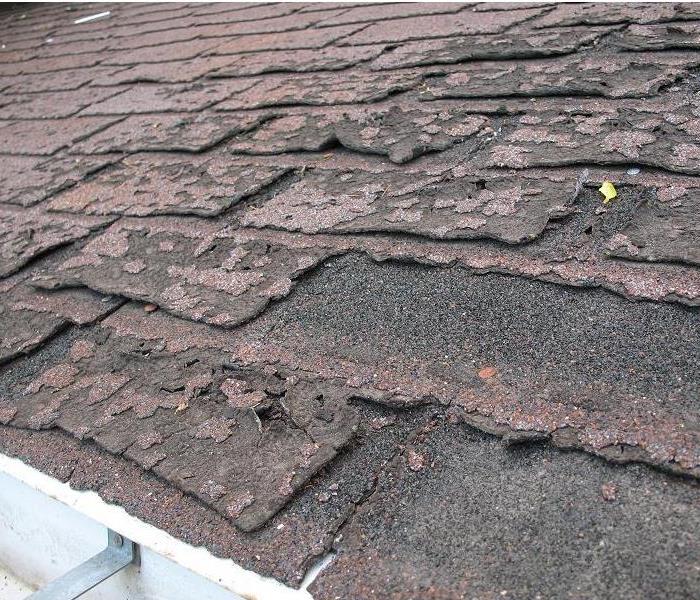
When it comes to storm and other weather-related damage, many people only think of the exterior structural damage to their property like fallen trees and damaged roofs. But what some people fail to realize is that exterior storm damage can often lead to interior water damage to their property. Water will always travel the path of least resistance and unfortunately after exterior structural damage to a property, this often means the water will end up inside the property. A quick response is crucial to help limit the additional interior damage. In the event of water or storm damage, SERVPRO of Boone County responds immediately, any time, day or night. We understand the importance of responding quickly to help prevent secondary damage and reduce restoration costs. Roofing service, board ups, roof tarps and tree removal are all among the emergency services we provide. Additionally, we are experts in water damage restoration and provide professional and efficient service to our customers. CLICK HERE to learn more!
American Red Cross Offers Mobile Apps
7/15/2019 (Permalink)
The American Red Cross has designed a great, new smartphone app designed to give users instant access to very valuable information. The app presents the user with lifesaving first aid instruction as well as helpful disaster preparedness information. The idea behind the app is that by having this useful information at the fingertips of millions of people, many lives will be saved.
The app includes videos and interactive quizzes. And to make learning more fun, users who take the quizzes can earn badges to share on social media and boast about their new lifesaving expertise!
Some highlights of the new app include:
- Every day scenario first aid instructions
- Emergency event instructions and 9-1-1 call button
- Shareable badges unlocked with interactive quizzes
- Videos and animations to make learning more fun
- Disaster preparedness tips for severe weather situations like hurricanes and tornadoes
This new app is free and available to all iPhone and Android users. To learn more, CLICK HERE to visit the American Red Cross website!
What to Look for During Severe Weather
6/3/2019 (Permalink)
The National Oceanic and Atmospheric Administration (NOAA) is a scientific agency within the United States Department of Commerce that focuses on the conditions of the oceans, major waterways, and the atmosphere. One of the main functions of NOAA is to warn of dangerous weather.
According to The Storm Prediction Center of the NOAA, when it comes to tornadoes, there is no guaranteed safety. Weather forecasting is not perfect, so it is possible for a tornado to occur without a warning. Knowing the signs of a tornado is one way to increase safety.
Here are several things the NOAA website says to look or listen for:
- Strong, persistent rotation in the cloud base.
- Whirling dust or debris on the ground under a cloud base -- tornadoes sometimes have no funnel!
- Hail or heavy rain followed by either dead calm or a fast, intense wind shift. Many tornadoes are wrapped in heavy precipitation and can't be seen.
- Loud, continuous roar or rumble, which doesn't fade in a few seconds like thunder.
These are just a few tips on what to look for during severe weather. More information can be found on the NOAA website. Tornadoes or severe storms often hit suddenly and can cause property damage that needs immediate attention. The SERVPRO of Boone County crews are always ready to help with services like securing a property, removing fallen trees, and tarping a roof. CLICK HERE to learn about other ways we are here to help.
Be Prepared & Stay Safe in the Event of a Tornado
4/8/2019 (Permalink)
Now that the warmer months have arrived, we are seeing beautiful flowering trees, warmer temperatures and budding tulips. But with the wonderful warmer season, also comes the threat of tornadoes.
Tornadoes often appear with little warning and bring strong, disastrous winds. Serious damage, including structural and water damage, often occur. While tornadoes are difficult to predict, we can prepare for them by thinking ahead and coming up with a tornado safety plan ahead of time.
Dr. Greg Forbes, a severe weather expert at The Weather Channel, suggests following these tips in order to be ready if a tornado strikes:
- Figure out a safe place to ride out the storm – If caught out in a storm, get home as quickly as possible, and if that’s not possible, get to a sturdy building.
- Get away from windows and get underground – Stay as far away from windows as possible and make every effort to get underground. A basement or a storm shelter is an ideal location to ride out the storm.
- If a tornado appears while you’re on the road… Make every attempt to find a safe building for shelter. If you can’t find one, NEVER hide under an overpass. It is safer to find a ditch, get down and cover your head. Get as far away from your vehicle as possible.
- Put on your shoes and a helmet – If you are home when the storm hits, prepare for the worst. Put on shoes just in case your home is damaged and you may be forced to walk through debris. If you own a bike helmet, it could save you from life-threatening head trauma.
- Keep your pets on a leash or in a carrier, and bring them with you – Your pets are part of your family so make sure to bring them with you to your safe place. Make sure their collar is on for identification and keep them leashed if they are not in a crate.
- Don’t leave your home and try to drive away from a tornado – Tornadoes can shift their path, and if you think you are directly in line of the storm, being in your home is safer than being in your car.
Tornadoes are unpredictable and can devastate a home and neighborhood in seconds. Flooding and water damage can also occur due to structural damage caused by the severe winds. Being prepared and knowing what to do if caught in a tornado increases the chances of safety and survival during the storm.
SERVPRO of Boone County is available 24 hours a day, 7 days a week to provide emergency service after storm damage. So if you need help, call us anytime!
859-746-3400
Minimize Business Interruption After Disaster by Developing an Emergency Ready Profile!
1/14/2019 (Permalink)
Studies show that after experiencing a disaster like a fire, tornado, or flood, many businesses never reopen or if they do survive, will shut down within 2 years following the disaster. As a business owner or manager, pre-planning ensures that emergency resources are available to you when you need them. This is why it is essential to have an emergency response plan and partner in place. Our professionals at SERVPRO of Boone County can help you put an emergency plan in place that will help protect your business from disaster.
With the SERVPRO Emergency Ready Plan, SERVPRO of Boone County becomes an important part of your disaster response plan by meeting with building administrators to collect site-specific information to ensure readiness should disaster strike. This information includes building layout, electrical, equipment and water protocols, etc.
By developing a SERVPRO Emergency READY Profile for your business, you minimize business interruption by having an immediate plan of action. Knowing what to do and what to expect in advance is the key to timely mitigation and can help minimize how water and fire damage can affect your business.
CLICK HERE to learn more about the SERVPRO Emergency READY Profile!
Holiday Travel Can Be Hectic!
12/17/2018 (Permalink)
Are you traveling during the holiday season? Many experience stress during the hustle and bustle of the holidays due to traveling during winter storms, heavy traffic or crowded airports. But taking steps to help cope with situations that may arise can help get you to your destination calmly. Travelchannel.com has provided the following tips to help you survive.
HOLIDAY TRAVEL TIPS
- Do Your Research: Plan alternative routes when traffic gets overwhelming. Maybe there is a more scenic route that might take a little longer but has less traffic. When flying, be sure to check the airline’s restrictions ahead of time. Know the fees for carry-on luggage and checked bags.
- Stay Connected: Load your smartphone with all the latest travel apps before leaving home. There are apps to provide updates on flights, airport lines, cheapest gas, cleanest bathrooms, etc. You name it and there’s probably an app for that!
- Pack Light: If possible, avoid checking bags at the airport altogether.
- Ship the Gifts or Give Gift Cards: For lighter travel, ship your gifts ahead of time or give gift cards.
- Travel on Off-Peak Days: The day before the holiday is always the most highly traveled. Try traveling on the actual holiday to avoid crowds and traffic.
- Travel Early or Late in the Day: Flights that leave early in the day are on-time more often. And avoid heavier traffic on the highways by traveling by car through the night.
Busy holiday travel is much easier to cope with if it is expected and planned for accordingly. While the hectic crowds and stress may not be completely avoided, one can definitely overcome the challenges by considering these tips when planning travel. Happy Holidays from SERVPRO of Boone County!
Upcoming Continuing Education Opportunity
11/28/2018 (Permalink)
We are hosting a Greater Cincinnati Insurance Board continuing education insurance credit course entitled, “Agents Ethical Responsibilities w/ Tom Ryan, AIC.” This course will discuss the ethical responsibility of the agent to the client and the insurance company in the transaction of insurance. It will review the legal and moral ethical responsibility in the transaction of insurance and examine the ethical duties an agent must understand. Topics will include introduction, ethical responsibilities of an agent, criminal activities of an agent, the justice system, negligence, duty of care agency law, and dual agency.
This course is approved for 3 credit hours in OHIO and KENTUCKY and will be held at our Covington, Kentucky location at 1001 Madison Avenue, Covington, Kentucky 41011 on Wednesday, December 12th, 2018 from 8:30am to 11:30am.
CLICK HERE for more information and to register!
SERVPRO of Boone County is Available for Emergency Service
8/27/2018 (Permalink)
Did you know that SERVPRO of Boone County offers emergency service 24 hours a day, 7 days a week? Fire, water, and storm damage doesn’t always strike during regular business hours. And often, at the most inconvenient times, homeowners find themselves in need of immediate service to secure their property after an emergency event.
SERVPRO of Boone County can provide temporary protective measures to prevent additional damage to the property after a disaster. Examples of these services include board ups, roof tarps, tree removal, temporary fencing and portable power. If after a fire or flood, the contents of a property need to be removed from the affected property during the restoration process, SERVPRO of Boone County can pack the contents and move them to our temporary warehouse location until the restoration process is complete. And once restoration is complete, the contents are then returned to the homeowners.
CLICK HERE to learn more about the emergency, building and reconstruction services we can provide. And remember, SERVPRO of Boone County is always Here to Help!
The Mission of the American Red Cross
7/30/2018 (Permalink)
The mission of the American Red Cross is to “help people prevent, prepare for, and respond to natural and other disasters through the immediate mobilization of people and resources and the provision of community, workplace, and school-based training.” In our area, the Greater Cincinnati/Ohio River Valley Chapter of the Red Cross organization serves 18 counties in Southwestern Ohio, Northern Kentucky and Southeastern Indiana. Examples of the types of disasters they respond to are floods, tornadoes, fires, and hurricanes. Many times, following a disaster, the American Red Cross workers are among the first on the scene. Their goal is to provide people with the support and resources they need, like food, clothing, and shelter.
Because of generous donations, caring volunteers, and abundant support, Red Cross relief services are free to those in need. The Red Cross totally relies on the generosity of the American public and there are many different ways to contribute. Some suggestions include:
- Monetary Donation
- Fundraising
- Giving Blood
- Taking, Teaching, or Hosting a Class
- Volunteering
If you would like to learn more about the American Red Cross and find out ways that you can help, visit their website by CLICKING HERE!
Continuing Education: We are hosting a class on July 10th!
6/18/2018 (Permalink)
We are hosting an upcoming Greater Cincinnati Insurance Board Continuing Education course on July 10th, 2018. The class will be held from 8:30am to 11:30am at our Covington, Kentucky office at 1001 Madison Avenue, Covington, Kentucky 41011. The title of the course is “Analyzing Commercial Property Rates with George Best, CSP, ARM. The presentation is designed to provide agents, brokers, and company representatives a detailed explanation of the Insurance Services Office (ISO) Commercial Fire ratings using the Specific Commercial Property Evaluation Schedule (SCOPES) of the ISO. Upon completion of the course, attendees should be able to review and analyze a rating survey in order to suggest rate improvement. This course is approved for 3 credit hours in Kentucky and Ohio. CLICK HERE for more information and to register!
Can the Carpet Be Saved?
1/29/2018 (Permalink)
When a homeowner is faced with a water damage situation in his home, he often wonders if the carpet and padding can be saved. When SERVPRO of Boone County is called for water restoration services in Erlanger, Kentucky, there are factors that the water technicians consider to help determine if the carpet and padding is salvageable.
Upon arriving to the site, the technicians will identify the category and classification of the water damage to ensure that the property is restored following industry guidelines. The level of contamination of the water helps determine whether or not the carpeting and padding can be saved.
There are three categories or classifications for floodwaters: Category 1, Category 2, and Category 3.
Category 1 is considered to be clean, non-contaminated water. It may come from overflowing tubs, leaky faucets, or broken pipes. In most instances of category 1 floodwater, the carpets and padding can be dried and restored.
Category 2 floodwater is classified as gray water. It is considered dirty water and it may result from malfunctioning washing machines or dishwashers for example. If the carpet has been wet for less than 48 hours, it can sometimes be restored. However, for category 2 floodwater, the padding is usually replaced.
Category 3 floodwater or black water is considered hazardous because it contains dangerous contaminants. Black water can come from instances like sewage backups and toilet overflows. In cases of black water floods, the carpeting and padding should be removed, disposed of and replaced.
The SERVPRO of Boone County technicians are experts in water restoration. They have the knowledge and expertise to inspect any situation and make professional decisions as to the appropriate restoration process to use.
If you are facing water damage in your Erlanger, Kentucky home, call us today! (859)746-3400!
Happy New Year from SERVPRO of Boone County!
1/1/2018 (Permalink)
Well, it is New Year’s Day and many will make resolutions for 2018 with aspirations of living a healthier lifestyle, losing weight, dropping a bad habit or being more organized. One important resolution to add to the list that could actually save lives in 2018 is to commit to getting prepared for emergencies.
Families and businesses need to have a plan in place just in case a disaster like a storm, fire or flood occurs. The American Red Cross offers a few steps to prepare your family or business in the case of an emergency.
First of all, put together an emergency kit for the home or the office. Suggested items to include in the kit are flashlights, non-perishable food and water, battery powered radio, extra batteries, first-aid items and extra cash.
Secondly, talk with family members or co-workers about what to do in the event of an emergency. Plan what to do if you are separated and choose a meeting place. Practice escaping your home or office twice a year. And don’t forget to include your pets in the plan!
And lastly, learn about the risks most prevalent to your area. For example, are earthquakes, tornadoes or hurricanes common in your area? Find out how to receive information from local officials in the event of an emergency. Learn first aid techniques so that you can respond before help arrives.
So this year, add being prepared for emergencies to your list of resolutions and stay safe in 2018! Be prepared!
Happy New Year from SERVPRO of Boone County!
How I Have Decided I Will Use My Basement
10/16/2017 (Permalink)
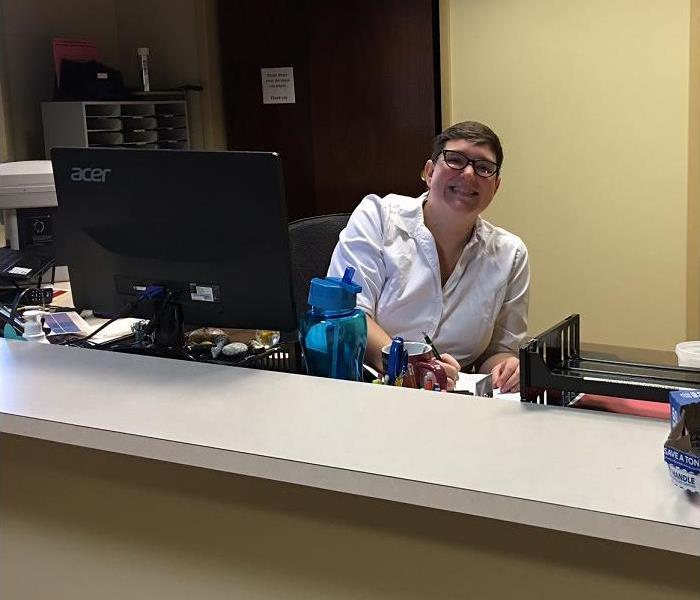 Cassie Recording Information After Taking a Call
Cassie Recording Information After Taking a Call
From the perspective of Cassie Kohrs – Administrative Assistant, SERVPRO of Boone County
When you think of buying a new home what do you envision? When I was younger I dreamed of the perfect basement where I could host parties and my future kids could play. I wanted to be able to walk out of my basement and right into my backyard. What I didn’t think of though, are the disasters that can happen that may make my picturesque home an expensive project to fix! As an administrative assistant at SERVPRO of Boone County, answering customer calls day after day, I have learned a few things! While I don’t own a home yet, I definitely hope to in the future. That is why I am thankful to this industry for teaching me what to look out for when I finally get to buy that dream home.
One of the very first things I noticed when I started working for SERVPRO of Boone County is a trend of storm damage to basements. When Cincinnati gets hit with heavy storms the most common place we clean up is the basement. We see damage all the time from sump pump failures, sewage backups, water flooding in from window wells, and underneath doors. Many times these basements are finished and we have to tear out carpet, padding, and drywall. These are often expensive to clean up and then put back together and in some cases the damage isn’t even covered by insurance. It didn’t take long for me to become disillusioned from that perfect finished basement! That however, doesn’t mean that this has to become wasted space.
Basements, even if unfinished can be a great place for many things. For instance, a basement makes the perfect laundry room. Growing up I didn’t have a finished basement but my dad built a great table that made the ideal work bench for folding laundry. A work bench like this could also be perfect as a crafting or tool table. Unfinished basement space can also be utilized as storage. But I have learned to make sure that items stored on the ground should always be in a deep plastic container so that, in the unfortunate event of a flood, the stored items are safer from water. Another good idea is to store the contents on racks that are at least a foot or two off the ground. And as an extra precaution, I would advise placing these in waterproof containers as well to help prevent water damage. This is especially essential if you are storing important papers, or family photos.
I personally am not disappointed that I won’t have a big fancy finished basement someday. I am perfectly happy to adjust that part of my future home. (It just means that I get to claim that as my crafting room!) I also don’t want to discourage others from having a finished basement. These are very nice spaces if you are willing to risk the possibility of flooding. However, I will say that if you have a finished basement or are interested in having one in the future, talk with your insurance company and find out what kind of coverage you have and what coverage is available. Also, make sure that you are prepared for this situation by keeping the SERVPRO of Boone County phone number handy. We are always here to help!
(859)746-3400
Flash Floods are Unpredictable
9/25/2017 (Permalink)
Flash floods are usually caused by excessive rainfall that occurs in a short period of time. They are dangerous because they are powerful, speedy and unpredictable. They can happen with little or no warning at all.
Densely populated areas are at a high risk for flash floods. Buildings, roads and parking lots in the area reduce the amount of rain absorbed by the ground. Sometimes streams that run through cities are routed into storm drains. These drains can become overwhelmed and flash flooding can result.
Areas near rivers are also at risk for flash flooding. If levees along rivers fail, flash flooding can result. In 2005, New Orleans experienced devastating floods during Hurricane Katrina due to the failure of the levees.
Dam failures and rapid runoff from mountains and steep hills can also cause flash flooding. When water is falling faster than the ground can absorb it, a dangerous, flooding condition can result.
No area is really immune to flash flooding. During storms it is important to pay attention to weather watches and warnings and take the necessary precautions. Always listen to forecasters and be prepared with a plan in place just in case a flash flooding situation arises!
Extreme Weather in the Midwest
8/28/2017 (Permalink)
Extreme weather is when a weather event in an area is significantly different from the usual weather in that area. While those living in the Midwest do not frequently experience severe weather conditions, there are a few times that weather does become an issue. Droughts, floods, tornadoes, and snow storms are all extreme weather events that can affect the midwestern states.
Droughts occur about once every 10 years in this area. When they occur, these severe dry spells pose significant problems for farmers.
Flooding in the Midwest is most frequent in the winter and spring seasons and affects areas that are normally dry. The many rivers and streams make the area susceptible to flooding when faced with intense or prolonged heavy rain.
Tornadoes occur in all parts of the world and at any time of day or year. But they are most common in the Midwest during spring and summer afternoons and evenings. Depending on the severity, tornadoes can cause devastating damage to cities, businesses and homes.
Six or more inches of snowfall in a single day constitutes heavy snow in the Midwest. This occurs several times a year in the northern parts but much less frequently in the southern areas. Extreme snowfall can cause damage to homes by collapsing roofs. Gusting winds that accompany blizzards also pose a threat to homes and business.
Happy July 4th...How will the weather affect fireworks this year?
7/3/2017 (Permalink)
Fireworks displays are affected by many different weather factors. Wind, drought, lightning and rain can all have an impact on July 4th celebrations.
Wind can really affect the quality of the display as well as pose a safety risk if not monitored closely. Calm wind doesn’t allow for the smoke to dissipate which means that the fireworks won’t be as vivid as spectators try to see them through the smoke. Strong wind affects the direction of the fallout, potentially blowing hot embers and smoke into the spectators.
A location experiencing a drought is not ideal for a fireworks show. This could be very dangerous as there is potential for fire damage when the fallout lands on dry grounds and possibly sparks a fire.
Lightning can also be one of the most dangerous weather conditions that affects a fireworks show. It is possible that lightning can strike the unlit fireworks and ignite them on the ground, which is very dangerous for anyone sitting nearby. It’s important to remember to always take shelter indoors if lightning is in the area!
And finally, while most would expect otherwise, rain is not really an issue for fireworks displays. As long as the pre-lit fireworks are protected from the rain so that the fuses are kept dry and will light, the fireworks will still burst through the raindrops and be seen without problems.
So this July 4th, be sure to take the weather into consideration as you head to your local fireworks display!
We at SERVPRO of Boone County wish you a happy and safe Independence Day!
SERVPRO of Boone County Ready to Respond for Disaster Recovery
6/12/2017 (Permalink)
Last October, Hurricane Matthew hit the Southeast coast of the U.S. leaving a trail of devastation and destruction. According to NationalGeographic.com, the hurricane’s storm surge and torrential rainfall caused severe flooding from Florida to North Carolina and inflicted damage in the U.S. estimated by analysts at a minimum of $10 billion. Many homes and businesses were left without power and sustained severe damage due to the high winds and flooding.
SERVPRO of Boone County is proud to be part of the national SERVPRO Disaster Recovery Team. This team provides help during events like tornadoes, hurricanes, blizzards or floods. The national SERVPRO System has a network of strategically positioned storm teams on standby should a disaster strike. Available 24 hours a day and 365 days a year, the SERVPRO Disaster Recovery Team is always prepared for the unpredictable. With the ability to mobilize local command centers, along with the resources of more than 1,700 Franchises nationwide, no disaster is too big.
During events like Hurricane Matthew, our local SERVPRO of Boone County crews are ready to quickly mobilize and help provide disaster relief to affected families and businesses in the area of the disaster.
Protect Your Pets During Storms
5/1/2017 (Permalink)
With the spring and summer seasons, severe storms become more frequent and tornadoes become a possibility. In the event of a tornado, most people consider the safety of their family, but many may forget to consider the safety of their pets. The Humane Society of the United States offers several tips to help keep pets safe during severe storms.
Tornado Safety Tips:
- Bring your pets inside – Any time a severe storm is in your area, bring your pets indoors. If it is not safe for you to be outside, then it is not safe for your four-legged friend!
- Make sure your pet is wearing a collar with identification or is microchipped – If you were to be separated from your pet during a storm, an identification tag or microchip will increase your chances of being reunited.
- Practice getting your pets into your safe place – When you practice your tornado safety plan with your family, be sure to include your pets as part of the practice plan!
- If you are forced to evacuate, take your pets with you – Even if you think you will only need to be gone for a short period of time, take your pets and some emergency pet supplies with you. Depending on the situation, you may be unable to come back for your pets at a later time.
These are just a few tips to take into consideration to help keep your pets safe during the stormy season. More information about tornadoes and pet safety can be found at the Humane Society website, http://www.humanesociety.org/issues/animal_rescue/tips/keeping_pets_safe_during_a_tornado.html.
SERVPRO of Boone County Provides Hurricane Relief
10/18/2016 (Permalink)
Hurricane Matthew pounded the Southeast coast leaving a trail of devastation and destruction. The storm brought strong winds, as much as 15 inches of rain and powerful storm surges to some areas. Many homes and businesses were left without power and sustained severe damage due to the high winds and flooding.
Many people’s lives were disrupted and SERVPRO of Boone County is making every effort to help those in need. As part of the national SERVPRO Disaster Recovery Team, our crews have mobilized and are currently onsite in South Carolina to help provide disaster relief to affected families and businesses in the area.
The employees of SERVPRO of Boone County are also working locally to provide hurricane disaster relief. On Saturday, October 15th, as part of the Contractor Connection Global Day of Service, a team of our SERVPRO employees and their families were honored to volunteer at Matthew 25: Ministries in Blue Ash, Ohio. Matthew 25: Ministries aids disaster victims and the poor by collecting, processing and shipping goods to them. To start the day, the SERVPRO group took part in a very informative tour and learned about the mission of Matthew 25: Ministries, what they do, and who benefits from their service. The SERVPRO group then contributed to the cause by unpacking and preparing items for shipment to those affected by Hurricane Matthew. It was a very satisfying experience for our SERVPRO employees to be part of such a wonderful cause!
SPRINGTIME CAN BRING SEVERE WEATHER
4/27/2016 (Permalink)
With the spring season comes lush green lawns, colorful flowering trees and warmer sunny days. However, spring can also be the prime season for severe weather. According to the American Red Cross, there are steps that can be taken to help ensure your safety if dangerous weather is predicted in your community.
Tornadoes often occur during the spring season between the hours of 3:00 and 9:00pm. The following are a few safety steps that can be taken to be ready if a tornado warning is issued is your area:
· Know your community’s warning system
· Pick a safe room in your home for your family to meet if a tornado is headed your way. This room should be a basement, storm cellar, or interior room on the lowest floor and should have no windows.
· Prepare your lawn for strong winds by removing damaged limbs from trees and securing lawn furniture, trash cans, hanging plants, etc.
Thunderstorms are also common in the afternoon and evening hours in the spring and can produce very dangerous lightning. A few thunderstorm safety tips recommended by the American Red Cross are:
· Where there is thunder, there is lightning! If thunder can be heard, then you are close enough to be in danger of lightning strikes. Go indoors!
· Postpone any outdoor activities, such as sporting events and picnics until the storm passes. It is possible to get struck by lightning even if it is not raining.
· Take shelter in a building or vehicle with windows closed and stay clear of the windows.
· Do not shower or bathe during a thunderstorm.
Spring can also be the time of year for flooding. Flash floods occur suddenly when water rises rapidly along a stream or low-lying area. Below are some safety steps recommended in the event of flooding:
· Be prepared to evacuate and head for higher ground.
· Stay away from floodwaters.
· Do not drive on flooded streets.
· Be especially cautious at night when it is more difficult to recognize flood danger.
While severe weather can be frightening, you can help ensure your safety and the safety of the ones you love, by being prepared and taking precautions.
NO DISASTER IS TOO BIG for SERVPRO of Boone County!
4/26/2016 (Permalink)
Need help fast in a storm situation? SERVPRO of Boone County is prepared to answer the call! The SERVPRO Disaster Recovery Team is a network of strategically positioned storm teams on standby, ready to act when disaster strikes. The Disaster Recovery Team is available 24 hours a day, 365 days a year, always prepared for the unpredictable. When localized storms overwhelm the local restoration companies, SERVPRO’s Disaster Recovery Team is there to help manage the workload. SERVPRO has mobilization teams across the country to travel as needed to support recovery after large storm events. With mobilized local command centers, management, crews, equipment and more than 1,650 franchises nationwide, the SERVPRO Franchise System has the ability and the manpower to relocate where needed and help make it “Like it never even happened.”

 24/7 Emergency Service
24/7 Emergency Service














